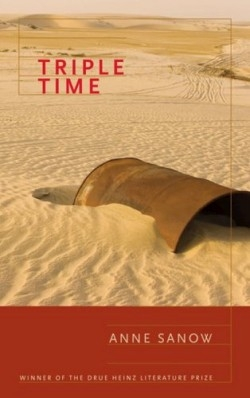Triple Time
There are shifting secrets hidden in the endless pockets of sand and rubble that provide a great deal of the atmosphere in Anne Sanow’s fascinating book Triple Time. And yet, human intrigue persists as well, when the action moves to the scrabble of Saudi Arabian commerce—the shops and carts, the stalls and alleys—all that bustle that fills the full range of modern conditions, from the paltry to the elegant. The temptation here is to label this an exotic and esoteric book, but it is the iconic characters that provide the fulcrum for these seven linked stories. Memorable books such as this reinforce the old saw that people are always more interesting than places.
Sanow’s characters embody the contrasts of culture and time, from the ancient desert landscapes dotted with Bedouin tents to the gleam of soaring apartment complexes and the zeitgeist of luxury western chic. For example, there is Gus, the pilot from Texas, in the title story, “Slow Stately Dance in Triple Time.” We meet Gus as he loops above the desert in a light-model biplane with his friend Basim in the passenger seat in front of him:
Falling into the downdraft the two men saw the sands gleaming like waves: they rippled and broke, and Gus could fig-ure, without having to hear Basim’s explanations, the patterns made by the shifting winds. It was a map.
Sanow understands that the real human drama here is in the reaction to the lonely wail of the call to prayer as it clashes with a Led Zeppelin record played by a ten year-old. It is in the tug and pull of ancient beliefs with the inexorable modernization in the Middle East that carries these characters along as if on a wave:
The village was crowded, but with the exception of the host’s new house the buildings in Al-Kharj strained to stand up to tradition. It wasn’t easy work; tradition was becoming malleable.
In the story, “The Date Farm,” Jill, a young American ex-pat woman, is beginning to feel enclosed in her new world after only two months. Thurayya and Ghusun, young Saudi sisters in a traditional family followed throughout the story collection, add a facet to the undercurrent of the subjugation of women.
Anne Sanow won the prestigious 2009 Drue Heinz Literature Prize chosen by novelist Ann Patchett. It was good fortune for this first collection, but after reading Triple Time, you’ll realize that the honor was no stroke of luck.
Reviewed by
Michael Lee
Disclosure: This article is not an endorsement, but a review. The publisher of this book provided free copies of the book to have their book reviewed by a professional reviewer. No fee was paid by the publisher for this review. Foreword Reviews only recommends books that we love. Foreword Magazine, Inc. is disclosing this in accordance with the Federal Trade Commission’s 16 CFR, Part 255.

